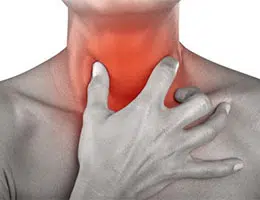 The tubular structure found after the mouth , in the neck area of humans and other mammals, is called the pharynx . Lined with a membrane, the pharynx allows the nasal passages and oral cavity to be linked to the larynx and esophagus, respectively.
The tubular structure found after the mouth , in the neck area of humans and other mammals, is called the pharynx . Lined with a membrane, the pharynx allows the nasal passages and oral cavity to be linked to the larynx and esophagus, respectively.
Located in front of the spinal column, the human pharynx extends approximately thirteen centimeters, from the base of the skull to the seventh cervical vertebra. A mass of muscles gives it support.
Air and food pass through the pharynx. In this way it can be said that it is part of the respiratory system and the digestive system. A cartilaginous piece called the epiglottis allows the two ducts to be separated.
Three sectors can be recognized in the pharynx. The lower pharynx , also known as the laryngopharynx or hypopharynx , runs from the border with the esophagus to below the epiglottis. The middle pharynx , oropharynx or oropharynx develops between the epligotis and the soft palate. The upper pharynx , nasopharynx or rhinopharynx , finally, extends from the soft palate to the posterior area of the nasal cavity.
The pharynx is involved in breathing (since air passes through it), swallowing (the food bolus enters through the mouth, crosses the pharynx and continues towards the esophagus), phonation (acts as a resonator) and hearing (it is linked to the pharynx). to the auditory tube).
Among the diseases and disorders that can affect the pharynx, pharyngitis is one of the most common. It happens when the mucosa surrounding the structure becomes inflamed, causing swallowing difficulties and other problems. Pharyngitis can be caused by an infection caused by a virus or bacteria or by an allergic reaction.
One of the most serious diseases in this context is pharyngeal cancer , which also leads to three others: nasopharynx , oropharynx and hypopharynx . In other words, this type of cancer speaks of several malignant tumors located in different specific points, although they all affect the throat . This occurs when tumor cells begin to spread in the tissues of the pharynx.
The first step in the emergence of any form of cancer is an abnormal cell mutation and its subsequent reproduction. When they mature, these cells can multiply without dying, and this explains their growth in number until the tumor forms.
Pharyngeal cancer can arise from several causes, although the World Health Organization assures that almost half of cancer cases worldwide appear due to tobacco consumption, an activity that is considered the cause of 90 percent of the conditions that occur. They take place in the oral cavity .
 Poor diet, based on the abuse of sugars and fats, and excessive alcohol consumption are other risk factors for pharyngeal cancer. Regarding the symptoms, we can point out the following:
Poor diet, based on the abuse of sugars and fats, and excessive alcohol consumption are other risk factors for pharyngeal cancer. Regarding the symptoms, we can point out the following:
* persistent cough and sore throat;
* ear or neck pain;
* presence of bumps in the area of the throat where the tumor is located;
* swallowing difficulties;
* considerable weight loss due to the previous symptom ;
* alterations in the voice due to the advance of cancer on the tissues, to the point of producing hoarseness.
Needless to say, smoking is harmful to health , so everyone should make an effort to get away from this habit. Since in this case you cannot say "it is never too late to quit", it is recommended to start the detoxification process as soon as possible. Improving diet, reducing alcohol consumption and exercising frequently are other useful tips to prevent pharyngeal cancer, among others.
